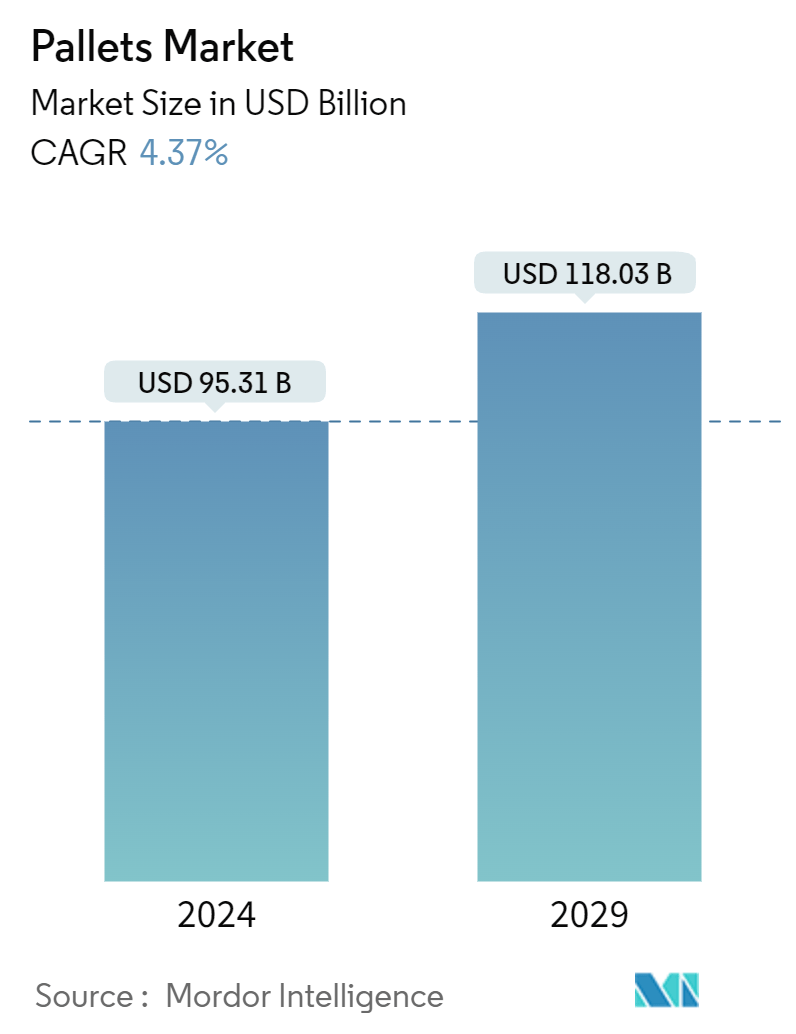Market Size of Pallets Industry

| Study Period | 2019 - 2029 |
| Market Size (2024) | USD 95.31 Billion |
| Market Size (2029) | USD 118.03 Billion |
| CAGR (2024 - 2029) | 4.37 % |
| Fastest Growing Market | Asia Pacific |
| Largest Market | North America and Europe |
| Market Concentration | Low |
Major Players
*Disclaimer: Major Players sorted in no particular order |
Pallets Market Analysis
The Pallets Market size is estimated at USD 95.31 billion in 2024, and is expected to reach USD 118.03 billion by 2029, growing at a CAGR of 4.37% during the forecast period (2024-2029).
- Surging demand for plastic pallets across industry verticals is expected to drive the market. In the past decades, wooden pallets were used mostly due to their strength and easy manufacturing process. However, due to certain disadvantages such as moisture absorption, less durability, and breakage of splinter, the demand for plastic pallets is growing.
- Advantages such as being environmentally friendly and lightweight and increasing awareness of reducing carbon footprint are propelling the demand for pallets in logistics and shipment companies as they are shifting from wood pallets to plastic pallets. In June 2023, C&T Matrix introduced its customers to a new range of plastic pallets specifically tailored to the requirements of the packaging industry. With over 1,000 pallets sold since its launch, customers cite improved safety and hygienic production as critical benefits.
- Moreover, due to its ability to handle heavy loads, the increasing demand for HDPE material in the automotive and shipping industry is boosting pallet demand. Disposable plastic pallets are widely used in the F&B industry as they resist organic and inorganic chemicals at average temperatures.
- The increasing adoption of pallets for transportation use is expected to drive the market during the forecast period. The primary transport mode for cross-border trade is through waterways (shipping), contributing to 90% of traded goods. This, in turn, indicates that oceans provide the main transport arteries for global trade. Furthermore, according to the Organization for Economic Cooperation and Development (OECD), maritime trade volumes are set to triple by 2050 as demand for global freight increases.
- However, limiting availability and the high price of the raw materials for manufacturing pallets are anticipated to hinder the market's growth. As wooden pallets capture the market, price fluctuations challenge market growth. The rising lumber prices, trucking issues, and high demand contribute to the worldwide shortage of wood pallets, nearly doubling raw materials prices.
- The pallet sector is moving toward a greener future. The pallet industry can play a role in the circular economy through reuse, repair, or recycling. Several global firms are making sustainable innovations to address the rising demand for reusable pallets. For instance, in September 2023, PVpallet announced its intentions to transform the solar shipping industry with one efficient, meaningful solution, replacing wood shipping pallets with ground-breaking reusable, recyclable shipping plastic pallets.
Pallets Industry Segmentation
The study tracks the demand based on the consumption of pallets globally across various end users listed in the study. The study factors in the impact of several geopolitical factors on the overall supply chain of the market, in addition to the prevalent base scenarios, key themes, and end-user vertical-related demand cycles.
The pallet market is segmented by types (wood, plastic, metal, and corrugated paper), end user (transportation & warehousing, food & beverage, pharmaceutical, retail, and other end user), and geography (North America [United States and Canada], Europe [United Kingdom, France, Germany, Italy, Spain, and Rest of Europe], Asia-Pacific [China, Japan, India, Australia and New Zealand, and Rest of Asia-Pacific], Latin America [Brazil, Argentina, Mexico, and Rest of Latin America], and Middle East and Africa [Saudi Arabia, South Africa, Egypt, and Rest of Middle East and Africa]). The market sizes and forecasts are provided in terms of value (USD) for all the above segments.
| By Types | |
| Wood | |
| Plastic | |
| Metal | |
| Corrugated Paper |
| By End User | |
| Transportation and Warehousing | |
| Food and Beverage | |
| Pharmaceutical | |
| Retail | |
| Other End Users |
| By Geography** | |||||||
| |||||||
| |||||||
| |||||||
| |||||||
|
Pallets Market Size Summary
The pallet industry is experiencing a significant transformation, driven by the increasing demand for plastic pallets across various sectors. Traditionally dominated by wooden pallets due to their strength and ease of production, the market is shifting towards plastic alternatives due to the latter's advantages, such as being lightweight, environmentally friendly, and resistant to issues like moisture absorption and pest infestation. This shift is particularly evident in industries like logistics, food and beverage, and pharmaceuticals, where the need for hygienic and durable solutions is paramount. The introduction of innovative products, such as those by C&T Matrix and PVpallet, highlights the industry's move towards sustainable and reusable options, aligning with global trends towards reducing carbon footprints and enhancing supply chain efficiency.
The market's growth is further bolstered by the expanding cross-border trade, especially in the Asia-Pacific region, where the emphasis on supply chain optimization is paramount. The region's rapid industrialization and urbanization, coupled with initiatives like India's "Make in India" campaign, are driving the demand for efficient material handling solutions like pallets. However, challenges such as the high cost of raw materials and the price fluctuations of wooden pallets pose obstacles to market expansion. Despite these challenges, the industry remains fragmented with numerous players, and ongoing innovations in sustainable practices and materials are expected to continue shaping the market landscape in the coming years.
Pallets Market Size - Table of Contents
-
1. MARKET INSIGHTS
-
1.1 Market Overview
-
1.2 Industry Attractiveness - Porter's Five Forces Analysis
-
1.2.1 Bargaining Power of Suppliers
-
1.2.2 Bargaining Power of Buyers
-
1.2.3 Threat of New Entrants
-
1.2.4 Threat of Substitutes
-
1.2.5 Intensity of Competitive Rivalry
-
-
1.3 Industry Value Chain Analysis
-
1.4 Assessment of Impact of Recent Geopolitical Scenario on the Industry
-
-
2. MARKET SEGMENTATION
-
2.1 By Types
-
2.1.1 Wood
-
2.1.2 Plastic
-
2.1.3 Metal
-
2.1.4 Corrugated Paper
-
-
2.2 By End User
-
2.2.1 Transportation and Warehousing
-
2.2.2 Food and Beverage
-
2.2.3 Pharmaceutical
-
2.2.4 Retail
-
2.2.5 Other End Users
-
-
2.3 By Geography**
-
2.3.1 North America
-
2.3.1.1 United States
-
2.3.1.2 Canada
-
-
2.3.2 Europe
-
2.3.2.1 United Kingdom
-
2.3.2.2 Germany
-
2.3.2.3 France
-
2.3.2.4 Italy
-
2.3.2.5 Spain
-
-
2.3.3 Asia
-
2.3.3.1 China
-
2.3.3.2 Japan
-
2.3.3.3 India
-
2.3.3.4 Australia and New Zealand
-
-
2.3.4 Latin America
-
2.3.4.1 Brazil
-
2.3.4.2 Argentina
-
2.3.4.3 Mexico
-
-
2.3.5 Middle East and Africa
-
2.3.5.1 Saudi Arabia
-
2.3.5.2 South Africa
-
2.3.5.3 Egypt
-
-
-
Pallets Market Size FAQs
How big is the Pallets Market?
The Pallets Market size is expected to reach USD 95.31 billion in 2024 and grow at a CAGR of 4.37% to reach USD 118.03 billion by 2029.
What is the current Pallets Market size?
In 2024, the Pallets Market size is expected to reach USD 95.31 billion.

